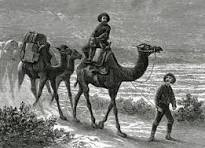In your next historical western, does your hero or heroine come across a camel? It could happen!
Having recently been given the surprising opportunity to ride a camel, I was encouraged to do a little research regarding dromedaries (one hump camels).
Their cloven hooves are huge, facilitating walking on sandy typed surfaces. I trim my goats' hooves, but these could be a challenge!The gear was equipped with bars to hold onto, for which I was thankful as the standing up and getting down movement of this big guy was quite tipsy.
The folks who rescued these two camels, occasionally load them up in horse trailers and take them to Arizona for desert camping. Apparently the animals really enjoy these treks.
Now to the cowboys and camels part. The United States Army experimented with using camels as pack animals in the American Southwest in the mid-1800s. Their attempt to replace horses and mules who struggled in the region's extreme temperatures, became known as the U.S. Army Camel Corps,
Using them for mounted cavalry failed pretty miserably, primarily because the structure of the camel's nose impeded breathing during hard exertion, reducing their ability for sustained speed. Their size also made them ineffective in close-quarter situations. But most importantly, the camels were greatly disliked by soldiers and other animals because of their odor and their disturbing habit of biting, spitting, or explosively defecating on anyone who tried to discipline them. They also required constant care to prevent a very contagious and difficult to treat form of mange.
The last camel mission before the Civil War broke out was directed by Robert E. Lee. This reconnaissance mission traveled over some of the harshest terrains in the United States. Still, the camels once again performed well, and none of the animals were lost.
So you see, in your next historical western, your H and H could very well come across a camel.
Here is an interesting Youtube Doug Baum's Texas Camel Corp
Blog www.ginirifkin.blogspot.com
Facebook https://www.facebook.com/people/Gini-Rifkin-Author/100001680213365
Amazon author https://amzn.to/2R53KA9
Pinterest https://www.pinterest.com/ginirifkin/pins/
Goodreads http://bit.ly/2OnHbrK
Barnes and Noble http://bit.ly/2xPs9S4
AudioBooks https://adbl.co/2OlWbGJ
LinkedIn https://www.linkedin.com/in/gini-rifkin-15950489/
Universal link https://books2read.com/u/3JLGMv
The wild rose press https://wildrosepress.com/?s=rifkin&post_type=product&type_aws=true












3 comments:
What a great post, Gini. Thanks for sharing!
What an interesting post! I've always wondered what it would be like to ride one :)
How interesting! I didn't know this.
Post a Comment